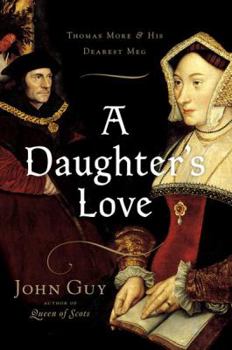A Daughter's Love: Thomas More and His Dearest Meg
Select Format
Select Condition 
Book Overview
With the novelistic vividness that made his National Book Critics Circle Award finalist "Queen of Scots" "a pure pleasure to read" ("Washington Post BookWorld"), Guy brings to life Thomas More and his... This description may be from another edition of this product.
Format:Hardcover
Language:English
ISBN:0618499156
ISBN13:9780618499151
Release Date:March 2009
Publisher:Houghton Mifflin
Length:448 Pages
Weight:1.81 lbs.
Dimensions:1.3" x 6.0" x 9.0"
Customer Reviews
5 ratings
Scholarship
Published by Thriftbooks.com User , 15 years ago
The scholarship and extensive research by John Guy, to write this book,is extremely impressive. To write about, and blend in facts concerning life in the 16th century is difficult enough, without having to address the uniqe personalities of historical characters, magnitude of issues, and complexity of what transpired in that era. The genre of the book makes for a pace of patient reading, but the content, and substance makes it very worthwhile.
Great Book
Published by Thriftbooks.com User , 15 years ago
For history buffs, for anglo-philes, for any reader, I have to say this is a well produced book.
Thank you, Mr. Guy
Published by Thriftbooks.com User , 15 years ago
This is a very well-documented book on the More family and life under King Henry VIII. The author really did his research and presents it as a very pleasing read. It is the best book written on the Thomas More. We also learn of what happened to the rest of the More clan and how life was like under the tyrant, King Henry VIII. A must for history buffs!
Plain Honest Men
Published by Thriftbooks.com User , 15 years ago
Excellent history of a very important event: the development of the Constitution of the United States and the effort to ratify it.
Father and Daughter
Published by Thriftbooks.com User , 15 years ago
There have been attempts to besmirch the reputation of Sir (Saint) Thomas More--unsubstantiated and denied rumors of torture, inflated numbers of executions for heresy under this administration as Chancellor, and emphasis on the more colorful language in his polemics against Luther and Tyndale. All are cited as unworthy of a canonized saint, either reflecting confusion about historical accuracy or what it means to be a saint. In this book, John Guy describes the relationship between Thomas More and his dearest daughter, Margaret Roper. It is a loving relationship, demonstrating the richness of character and integrity of both father and daughter. Guy highlights Thomas More's progressive educational program for all his children, including his daughters, uncommon at the time, with the highest standards of contemporary humanism. Erasmus of Rotterdam found in Margaret More Roper a critical and discerning reader who could appreciate his efforts and correct his Latin. Crucially, John Guy emphasizes that Thomas More had completely integrated the sacred and the secular in his way of life and yet steadfastly kept the public and the private aspects of his life separate. When he was with his family, or when he wrote to them when he was away from them, he did not discuss the efforts, burdens or issues of his working life, as lawyer, member of Parliament, ambassador, or Chancellor. It was only when he knew that public life was going to intrude violently and with deadly force on his private life that he gave his family a sign of what was to come: a brutal knock at the door, interrupting the family gathered at meal and a preemptory summons to answer charges of treason. Also crucially, Guy highlights the ferocious will to power of Henry VIII once he knew what he wanted and experienced the satisfaction of obtaining it. Henry was then insatiable and only those who bowed utterly to his desire could hope to survive, and even they faced the danger of his changing mood and will. Thomas More tried to warn Thomas Cromwell (as depicted in the film "Anne of the Thousand Days") never to let the king focus on what he could do, but only on what he should do. More followed his own advice and was executed; Cromwell did not follow that advice and was still executed. Margaret was one of the few who knew her father wore a hair shirt; she would thus be the only one who knew how to sustain him during his imprisonment in the Tower, engaging him with both intellectual diversion and prayer. She would be his champion after his execution, rescuing his head from its place in the row of traitors and preserving all his works, including the letters and treatises he wrote in the Tower, so that they could be published during the reign of Mary Tudor, Henry VIII and Catherine of Aragon's surviving child and the first Queen Regnant of England, Ireland and Wales. A sad and final irony I gained from the story of this relationship was an inkling of what might have been: if Henry VIII could have






